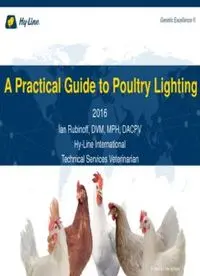
A Practical Guide to Poultry Lighting PDF
Preview A Practical Guide to Poultry Lighting
A Practical Guide to Poultry Lighting 2016 Ian Rubinoff, DVM, MPH, DACPV Hy-Line International Technical Services Veterinarian © Hy-Line International Outline Poultry biology Understanding light Measuring light Impact of painting lights red Lens dispersion and dimming LED light overview Choosing the right light © Hy-Line International Human wavelength recognition 100% 90% 80% 70% 60% 50% 40% 30% 20% 10% 0% © Hy-Line International 380 395 410 425 440 455 470 485 500 515 530 545 560 575 590 605 620 635 650 665 680 695 710 725 740 755 770 Fowl wavelength recognition 100% 90% 80% 70% 60% 50% 40% 30% 20% 10% 0% © Hy-Line International 380 395 410 425 440 455 470 485 500 515 530 545 560 575 590 605 620 635 650 665 680 695 710 725 740 755 770 Comparison 100% 90% 80% 70% 60% 50% 40% 30% 20% 10% 0% © Hy-Line International 380 395 410 425 440 455 470 485 500 515 530 545 560 575 590 605 620 635 650 665 680 695 710 725 740 755 770 Lux versus clux The International Commission on Illumination (CIE) standard for measuring light intensity is set at the peak human response Humans only have one photopic spectral peak that is calculated between 550 – 560 nm. Chickens have 3 photopic spectral peaks (around 480, 560, and 625 nm); therefore some additional calculations are required. Depending on the light source and peak spectrum, there can be a 50% or greater difference between the lux and clux. © Hy-Line International Poultry biology B asic Physiological effects of light: 1. Facilitate sight - Food search 2. Stimulate Internal Cycles - Circadian- day length changes 3. Initiate and regulate hormone release - Metabolic regulation: fat & muscle deposition - Reproduction - Calcium, phosphorus, and bone formation © Hy-Line International Poultry biology Reception: 1. Retinal - Cone photoreceptors - Visual perception - Dopamine & UV-A ↔ melatonin 2a. Pineal “Soul gland” - Photoreceptors (>4 lux) 2a. - Circadian clock: serotonin and melatonin 2b. Hypothalamic Sexual Maturity - Deep encephalic photoreceptor - Sexual hormones 2b. © Hy-Line International Spectral transmission into the hypothalamus in birds 100% 90% 80% 70% 60% 50% 40% 30% 20% 10% 0% 380 430 480 530 580 630 680 730 780 © Hy-Line International Spectral transmission into the hypothalamus in birds Transmission relative to red (650 nm) Wavelength (nm) Quail Sparrow Pigeon Ducks Violet (400-435) 0.013 0.018 0.275 Blue (435-500) 0.023 0.055 0.098 0.027 Green (500-565) 0.020 0.067 0.113 0.096 Yellow (565-600) 0.090 0.135 0.158 0.244 Orange (600-630) 0.271 0.280 0.410 Red (650) 1.000 1.000 1.000 1.000 Red (700) 2.927 11.681 © Hy-Line International
